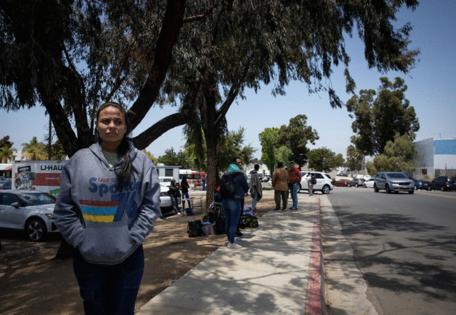Shifting migrant routes make San Diego the new hotspot for illegal border crossings
Published in News & Features
SAN DIEGO — San Diego County has become the busiest corridor for illegal crossings along the U.S.-Mexico border as popular migration routes have continued to shift west from Arizona and Texas, according to the latest U.S. Customs and Border Protection data.
Last month, U.S. Border Patrol encountered 37,370 migrants along the 60 miles of border that span the San Diego Sector, a 49% increase when compared with April 2023. While the Tucson Sector — the busiest along the border until last month — still leads in the number of apprehensions so far this fiscal year, the April flip is not surprising to those who have witnessed the increasing number of migrant arrivals in San Diego since the fall.
"There is some notion that crossing through San Diego is less risky," said Pedro Ríos, director of the American Friends Service Committee's U.S.-Mexico Border Program, whose organization for months has been providing humanitarian aid to arriving migrants waiting to be processed between the two fences near the San Ysidro border crossing.
Some migrants have told him that they preferred to come to San Diego because of information they received from other family members or acquaintances who had made the journey into the U.S. Others tried through another border city, but when they were intercepted by Mexican agents, they decided to try again from here.
But the biggest effect, according to him and others, has been Texas' multibillion-dollar effort to secure its border with Mexico. All of the Border Patrol Texas sectors showed a decrease in the number of encounters last month compared to April 2023.
Texas Gov. Greg Abbot took credit for it on X, formerly known as Twitter.
"Thanks to our stiff resistance, illegal crossings continue to shift to other border states — with California now the epicenter of Biden's border crisis," he wrote earlier this month.
While Border Patrol apprehensions increased by nearly 11% from March to April in San Diego, they fell overall across the southwestern border by 6%, according to the data.
"CBP continues to surge resources and personnel to impacted sectors along the border to ensure the safe, swift, and orderly processing of individuals to maximize expedited removals," acting CBP Commissioner Troy Miller said in a statement.
He credited increased enforcement measures on bucking previous springtime trends of increased illegal migration but promised to "remain vigilant to continually shifting migration patterns."
Tijuana officials agreed that the situation in Texas has forced migrants to seek new routes. Enrique Lucero, director of the Migrant Affairs Office in Tijuana, said they have been expecting numbers of migrants to increase locally as a result.
"A lot of asylum seekers are arriving in Tijuana," Lucero said. "They fall into paying smugglers. It's out of control."
The steady pace was continuing this month. From May 1 to 14, about 16,300 apprehensions were recorded in the San Diego Sector, according to figures shared Wednesday by Sector Chief Patricia McGurk-Daniel on X.
County Supervisor Jim Desmond, who has pressed for the federal government to curb illegal crossings, called San Diego "the new epicenter for migrants and illegal immigration."
"Human smugglers have identified California, particularly the San Diego border sector, as the path of least resistance for illegal immigration," he said.
Mexico has implemented measures to try to deter irregular crossings into the U.S. South of the border, Mexican authorities have installed a chain-link fence along a stretch of the Tijuana River canal, in addition to checkpoints in places with a high number of crossings. Mexico has also been increasingly busing migrants to cities farther south such as Tapachula.
But migrants continue to come, particularly through remote areas of the border near Jacumba Hot Springs, where migrants slip through gaps in the fence or find ways over or through the barrier. Then they wait in the desert for Border Patrol to pick them up, process them and release them in San Diego County.
In April, they came from all over the world, with very few from Mexico or Central America.
"It was the place we were told," Jormary, a migrant from Colombia who asked to be identified only by her first name for her safety, said Thursday about why she crossed in San Diego. Others have said over the past several weeks that they followed advice from people who had already crossed or heard it on social media.
The situation looked different in the 1980s and 1990s, when San Diego led all sectors in such border crossings. Back then, migrants crossing between ports of entry ran from Border Patrol.
After 524,231 apprehensions in 1995, the numbers began to drop after the implementation of Operation Gatekeeper, which focused on a strategy using manpower, technology and multiple layers of fixed positions to deter illegal crossings. A new border fence made of helicopter landing pads from the Vietnam War was installed in the region around the same time.
Ríos, who has worked as an immigrants-rights defender in San Diego since the '90s, noted how things have changed ever since. "Nowadays migrants crossing the border are not trying to evade authorities," he noted. "They are now turning themselves in with this idea that they can initiate an asylum process."
The number of apprehensions increased in San Diego again after 2020, slowly shifting away from years of heightened activity in the Rio Grande Valley.
"That's the way migration is," Lucero said. "There are times when the numbers go down and times when they go up."
The numbers locally have been noticeably larger since the fall, causing humanitarian groups and the county to struggle to provide for the tens of thousands of migrants who have been released from Border Patrol custody. The vast majority don't plan to stay in San Diego but are headed to destinations across the U.S., where they will then file asylum claims.
The county Board of Supervisors is expected to vote Tuesday on a plan that would continue to move toward a new migrant transition day center to be paid for with $19.6 million in newly secured federal funding.
The county previously allocated $6 million for a temporary migrant center — a place where migrants could eat, get resources for the next leg of their journeys and charge their cellphones — but it was forced to close earlier than expected due to lack of funding. As a result, Border Patrol resumed the daily releases of adult migrants at a public transportation center in south San Diego, where they are met by humanitarian groups for assistance.
On Thursday, a group of migrants waited at the transit center for their loved ones who were still in Border Patrol custody. Jormary, the Colombian woman, said she was released on Monday and has since returned to the station every day to wait for her partner. With nowhere to go, she said she initially slept at the airport, but she recently found a shelter.
©2024 The San Diego Union-Tribune. Visit sandiegouniontribune.com. Distributed by Tribune Content Agency, LLC.







Comments